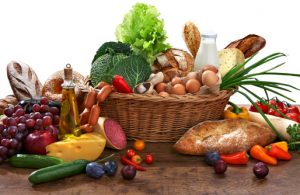 When you look at a food label you’re presented with a few different things. Fat, sugar, carbohydrates and nutrients are all clearly labeled, with either a percentage or a measurement of how much that food item contains. These guides can help us make informed decisions about the foods we eat, which can be crucial if we need to enjoy a special diet.
When you look at a food label you’re presented with a few different things. Fat, sugar, carbohydrates and nutrients are all clearly labeled, with either a percentage or a measurement of how much that food item contains. These guides can help us make informed decisions about the foods we eat, which can be crucial if we need to enjoy a special diet.
For example, diabetics must be mindful of the amount of sugar they consume. Yet, even though you may pay extra attention to sugar, carbohydrates may actually be a more accurate factor when it comes to spikes in blood sugar.
Advertisement
You see, carbohydrates turn into sugar – a fact that is often overlooked. We tend to see the word sugar and then ignore the fact that the amount of carbohydrates in the food we consume can also increase our blood sugar levels.
So whether you’re diabetic or not, if you’re looking to maintain healthy blood sugar, it’s wiser for you to know a food’s glycemic index and glycemic load (GI and GL).
Related reading: Type-2 Diabetes or Pre-diabetes Present in Almost Half of all U.S. Adults
What is the glycemic index?
 The home of the glycemic index comes from the University of Sydney in Australia. They provide an international database of glycemic indexes for a variety of foods. They are also responsible for providing up-to-date information for consumers to help them make informed decisions when choosing what foods to eat.
The home of the glycemic index comes from the University of Sydney in Australia. They provide an international database of glycemic indexes for a variety of foods. They are also responsible for providing up-to-date information for consumers to help them make informed decisions when choosing what foods to eat.
But what exactly is the glycemic index? Well, as mentioned, carbohydrates can affect blood sugar levels. The glycemic index ranks those carbohydrates between zero and 100 based on their ability to raise blood sugar. Foods that are digested quickly tend to have a higher glycemic index because they raise blood sugar rapidly. On the other hand, foods that are digested slowly fall on the lower side of the scale.
When it comes to diabetes, it is recommended that those with the illness stick with foods with a low glycemic index. This is because they respond better to insulin and can aid in weight management as well as feeling fuller longer – all important aspects of managing diabetes.
Both the World Health Organization (WHO) and Harvard School of Public Health have made recommendations through research suggesting that people should try to eat foods with a low glycemic index as foods with a high one have been linked to numerous illnesses, such as diabetes and heart disease. They found that by eating low glycemic index foods people could prevent such illnesses.
How to determine a food’s glycemic index
Now that we have a better understanding of glycemic index, let’s explore how it’s formed.
Portions of food are set aside, which contain at least 50 mg of carbohydrates. If a food naturally has lower carbohydrates, then the portion sample will only contain 25 mg. With the help of 10 healthy people, they are served the food item after they have fasted overnight. Once consumed, blood samples are taken every 15 to 30 minutes over the span of two hours.
A number is then calculated, referred to as the incremental area under the curve (iAUC), which shows the total increase in blood sugar post-meal. The iAUC from the test food is then divided by the iAUC from the reference food and multiplied by 100. The average is calculated from all 10 participants and that becomes the glycemic index.
Glycemic index foods that are considered low have a score of 55 or less. Medium glycemic index foods are 56 to 69 and high glycemic index foods rank 70 or more.
Currently, it is not mandatory that food companies include the glycemic index on their product labels. Some countries, like Australia, do indicate the glycemic index to help consumers. The lack of information is largely in part due to the fact that testing for GI is not widely available, so it can take quite some time to retrieve accurate information.
Related reading: Blood sugar levels now easier to control
What is glycemic load?
 On the other side of monitoring blood sugar is glycemic load. Where glycemic index measures how much a food can raise blood sugar, glycemic load is how much carbohydrates affect insulin. This can help people control their portions and understand how the amount they eat can affect their blood sugar.
On the other side of monitoring blood sugar is glycemic load. Where glycemic index measures how much a food can raise blood sugar, glycemic load is how much carbohydrates affect insulin. This can help people control their portions and understand how the amount they eat can affect their blood sugar.
Glycemic load is calculated by multiplying the glycemic index by the amount of carbohydrates a food item has and dividing it by 100 (GL = GI x carbohydrates / 100).
Although the glycemic index is ranked from zero to 100, the glycemic load ranks a little differently. A low glycemic load is classified as being between zero and 10. A medium glycemic load is 11 to 19 and a high glycemic load is anything over 20.
Knowing the glycemic load is useful for anyone, but it is particularly of high significance for those with diabetes. Similar to why a diabetic should know glycemic index, glycemic load can further help a diabetic eat well without creating spikes in their blood sugar.
50 common foods with their GI and GL values
 In North America, it isn’t as common to see a glycemic index or glycemic load value on food items. With the help of an online search it may be a bit easier to obtain such information.
In North America, it isn’t as common to see a glycemic index or glycemic load value on food items. With the help of an online search it may be a bit easier to obtain such information.
Below you will find 50 of the most common foods, along with their glycemic index and glycemic loads. This way you can have a better baseline understanding of how food affects your body. Furthermore, you can use the information as a basis to create a glycemic index and glycemic load diet to help manage blood sugar.
Glycemic index and glycemic load foods chart
| Foods | Glycemic Index | GI Rank | Glycemic Load | GL Rank |
|---|---|---|---|---|
| Sponge cake, plain | 46 | low | 17 | medium |
| White bagel | 72 | high | 70 | high |
| Hambuger bun | 61 | medium | 9 | low |
| White pita bread | 68 | medium | 10 | low |
| Whole wheat bread | 71 | high | 9 | low |
| Soda | 63 | medium | 16 | medium |
| Unsweetened apple juice | 44 | low | 30 | high |
| Unsweetened orange juice | 50 | low | 12 | medium |
| Quinoa | 53 | low | 13 | medium |
| White rice | 89 | high | 43 | high |
| Brown rice | 50 | low | 16 | medium |
| Ice cream | 57 | medium | 6 | low |
| Milk, full fat | 41 | low | 5 | low |
| Apple | 39 | low | 6 | low |
| Banana | 62 | medium | 16 | medium |
| Grapefruit | 25 | low | 3 | low |
| Grapes | 59 | medium | 11 | medium |
| Orange | 40 | low | 4 | low |
| Peach | 42 | low | 5 | low |
| Pear | 38 | low | 4 | low |
| Watermelon | 72 | high | 4 | low |
| Black beans | 30 | low | 7 | low |
| Chick peas | 10 | low | 3 | low |
| Kidney beans | 29 | low | 7 | low |
| Peanuts | 7 | low | 0 | low |
| Fettucini | 32 | low | 15 | medium |
| Macaroni | 47 | low | 23 | high |
| White boiled spaghetti | 46 | low | 22 | high |
| Plain popcorn | 55 | medium | 6 | low |
| Potato chips | 51 | low | 12 | medium |
| Carrots | 35 | low | 2 | low |
| Boiled white potato | 82 | high | 21 | high |
| Sweet potato | 70 | high | 22 | high |
| Hummus | 6 | low | 0 | low |
| Pizza with sauce and cheese | 80 | high | 22 | high |
| Honey | 61 | medium | 12 | medium |
| Salted cashews | 27 | low | 3 | low |
| Lentils | 29 | low | 5 | low |
| Raisins | 64 | medium | 28 | high |
| Pitted prunes | 29 | low | 10 | low |
| Dried dates | 42 | low | 18 | medium |
| Shortbread | 64 | medium | 10 | low |
| Special K cereal | 69 | medium | 14 | medium |
| Pumpernickel bread | 56 | medium | 7 | low |
| Wheat tortilla | 30 | low | 8 | low |
| Oatmeal | 55 | low | 13 | medium |
| Rice cakes | 82 | high | 17 | medium |
| Soda crackers | 74 | high | 12 | medium |
| Reduced-fat yogurt with fruit | 33 | low | 11 | medium |
**GI and GL based on one single serving size
Eating a glycemic index and glycemic load diet
Now that you are familiar with 50 of the most common foods and their GI and GL, you can begin to be more mindful about incorporating them into your diet. By eating right and avoiding spikes in blood sugar you can ward off illness and manage your diabetes more effectively. Of course, other aspects like proper sleep and physical activity can also impact healthy living and should be a priority.
Whether you’re diabetic or not, being aware of glycemic index and glycemic load can be beneficial to overall good health. Preventing diabetes, especially if it runs in your family, is as easy as eating right, and that is where GI and GL can come in handy. Although both measurements may not be as well-known now, hopefully food companies will move in a direction that will provide us with such information so that we become better informed and conscious consumers.
Related Reading:
Turning 50? You could be at risk for diabetes
Getting older has its pluses – life experience, wisdom, longstanding relationships. Our senior years can be fulfilling ones. But the other side of that coin is we’re more prone to chronic disease because of our aging bodies. There’s the wear and tear of time, and the cumulative result of not-so-healthy habits we may have followed over many, many years. Continue reading…
Advertisement
Effective natural remedies for diabetes
Diabetes is a disease where there is excess sugar in the blood. But why is it there and what can you do about it? Before we look at natural remedies for diabetes and effective tips for avoiding diabetes, let’s discuss why sugar is such a big deal – and why our body needs to be able to use it effectively. Continue reading…
Sources:
http://www.diabetes.co.uk/diet/glycemic-load.html
http://www.glycemicindex.com/about.php
http://www.diabetes.org/food-and-fitness/food/what-can-i-eat/understanding-carbohydrates/glycemic-index-and-diabetes.html
http://lpi.oregonstate.edu/mic/food-beverages/glycemic-index-glycemic-load
http://www.health.harvard.edu/healthy-eating/glycemic_index_and_glycemic_load_for_100_foods
